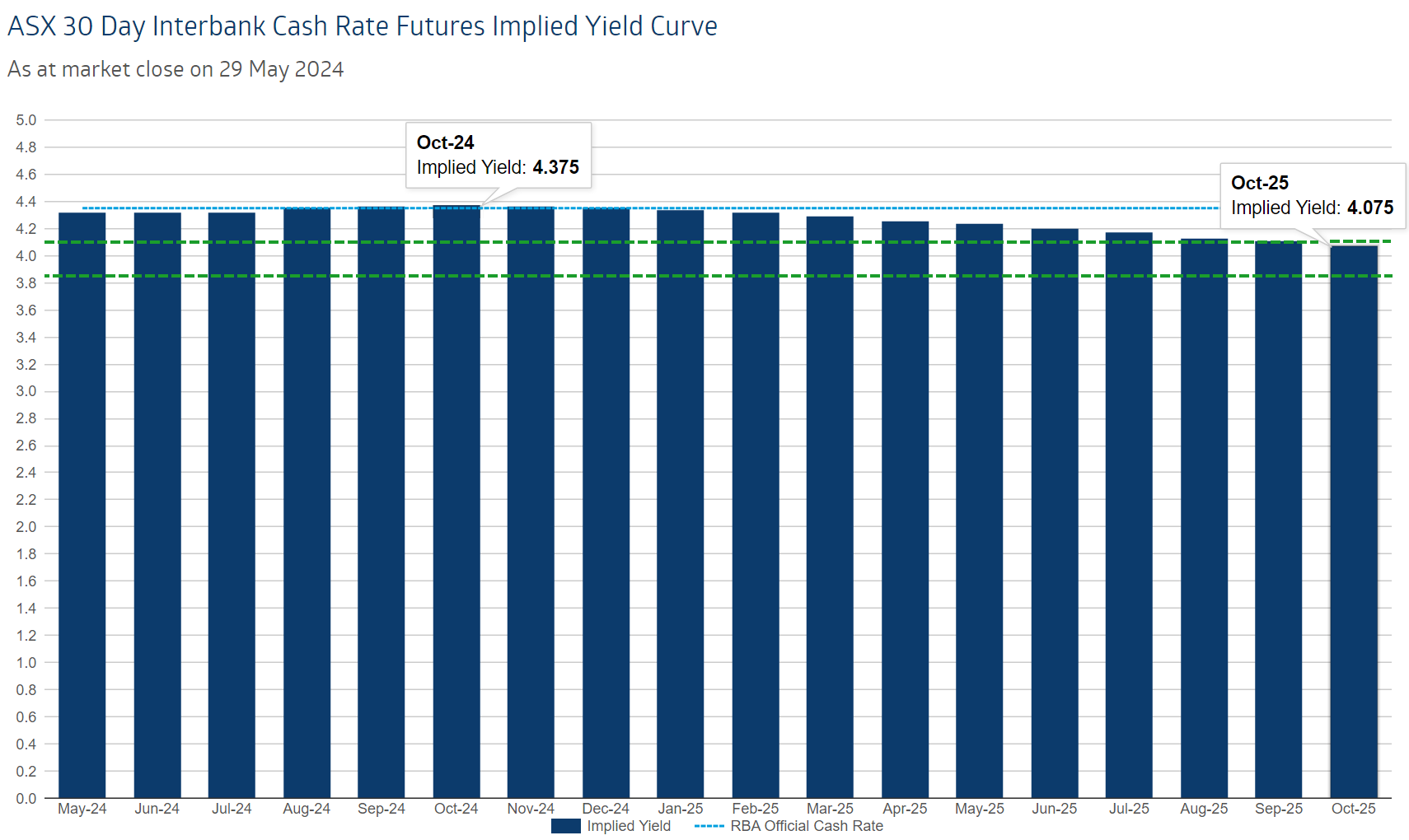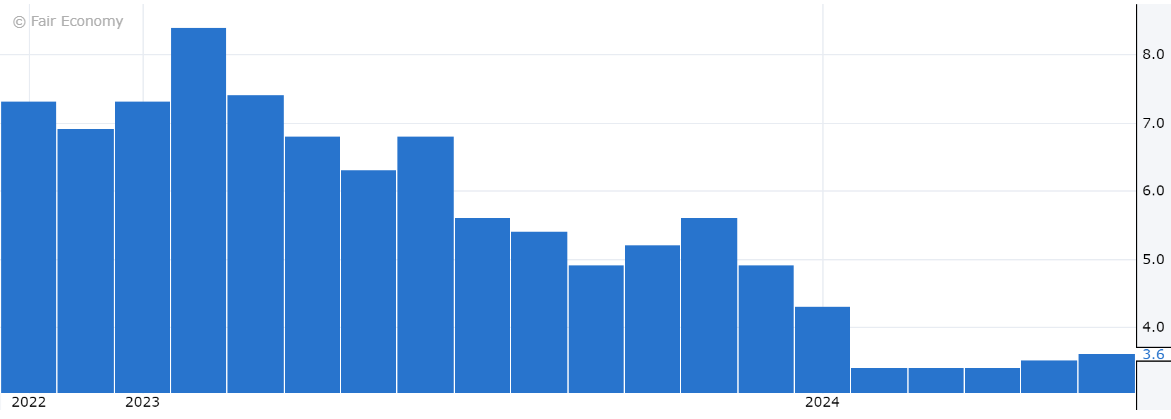The RBA won’t hike again, but cuts pushed into (very) distant future
Slap!
A sound that reverberated across the nation at exactly 11:30am EST Wednesday. It was the sound of palms meeting foreheads at the Reserve Bank of Australia.
The ensuing headache for RBA officials will likely be ongoing, as they grapple with the conundrum of what to do about very sticky Aussie inflation.
For the uninitiated, our RBA has a few main things it’s been tasked to do by the Australian Government. Perhaps the best-known is its inflation target range of 2-3% p.a.
Despite the hysterical headlines you’ll see splashed across the mainstream media, yesterday’s worse-than-expected uptick in April’s consumer price index (CPI) is not likely to result in another interest rate hike – at least market pricing this morning does not indicate this.
Let me explain why I (and so far, the market) think rates are unlikely to rise and why yesterday’s CPI data is still bad news for Aussie mortgage holders.
Will there be another interest rate hike in Australia?
Yes, of course, eventually – but it’s unlikely to be in this cycle!
According to the Reserve Bank Act 1959, the RBA has several important responsibilities written into its charter:
a. the stability of the currency of Australia;b. the maintenance of full employment in Australia; and
c. the economic prosperity and welfare of the people of Australia.
You’ll notice that there’s absolutely nothing in there about inflation, and if anything, it appears the RBA’s main goals are full employment and economic growth.
Since the 1990s, the RBA’s main tool for achieving its mandate has been monetary policy – the main tool of which is controlling the official cash rate (OCR). The OCR is the benchmark rate from which Australian deposit and lending rates are set.
The big question is, if increasing the OCR is likely to cause Aussies to lose their jobs and the economy to slow down, isn’t this contradictory to the RBA’s charter?
The short answer is: Yes (but that’s just how economics works).
Not wanting to sound dispassionate here, when it comes to economics you have to break a few eggs to make the proverbial omelette.
Economists generally consider the scourge of inflation, particularly runaway inflation via runaway inflation expectations, to be far worse than the downside of the interest rate hikes used to control it.
The RBA constantly treads a fine line between appearing tough on inflation and not tanking the economy and costing people their jobs. It’s not one or the other; it’s a fine balancing act to achieve both.
And this is why we’re unlikely to see further rate hikes in this cycle. All recent evidence confirms the economy is slowing, and we even saw a modest uptick in the unemployment rate last month. The RBA, particularly Governor Michelle Bullock has gone to great pains to remind us that policy is at a level that they feel is “restrictive”.
This means the current level of the OCR is impeding the Australian economy. Also, consider their inflation target is a range that is to be achieved over time, so even though the April CPI ticked back up to 3.6% from 3.4% in March, it’s not completely out of kilter with the RBA’s target.
The broader trend in Aussie inflation is still down, and great progress has been made since the peak in early 2023.
Hike vs cut probabilities and timing
I suggest you stop reading clickbait headlines about interest rate hikes and start looking at data on how markets are actually pricing future RBA moves. The best place for the average investor to do this is the RBA Rate Tracker, published daily by the ASX.
Scroll down the page a little, and you’ll get to my favourite bit – the ASX 30-Day Interbank Cash Rate Futures Implied Yield Curve. This tool leverages pricing of Australian interest rate futures to create a schedule of the market’s expected level for the OCR for the next 18 months.
Ultimately, the implied yield curve is created by the movement of massive amounts of capital, managed by the smartest money managers locally and abroad. It’s safe to say they’ve done their homework on all available information, and while they can still get it wrong, the implied yield curve remains an excellent tool for understanding future moves in the OCR.
Here’s what it looked like before yesterday’s shock CPI reading:

Note that the implied yield curve topped out at 4.34% in August (also in October). Given the current OCR is 4.35%, this means that before the April CPI the market was pricing in a 0% chance of another interest rate hike (despite plenty of scaremongering in the media to the contrary).
The curve clearly shows that market thinking was exclusively about cuts, and it was just a matter of how much and when. In terms of how much, I’ve drawn in green dashed lines at -0.25% intervals – so 4.10% and 3.85%. The implied yield curve first dips below 4.10% in July 2025, i.e. the market was factoring a 100% chance of a 0.25% cut by then.
Given that the implied yield by October 2025 was 3.96%, this suggests the market was not expecting a 100% probability of a second cut within the look-forward period. However, it was factoring in 0.14% of a 0.25% cut, so we can say the market was factoring in a 56% chance of a second 0.25% cut by October next year.
This is what the implied yield curve looks like now:

There’s definitely a shift after the April CPI – up and across. Also, the dark blue bars are now tipping over the dashed blue line representing the current 4.35% OCR. But the new peak at 4.375% in October only implies a 10% chance of a 0.25% hike by then. I suggest very much an outlier.
As for the first rate cut, the implied yield curve only dips below the 4.10% delineator in October 2025. So, the April CPI data has shifted the market’s perception of the timing of the first cut by 4 months from June 2025 to October 2025. Also, it’s likely pushed the timing of a second cut well beyond the edge of the current look-forward period.
A moving target
We’ve talked a great deal about probabilities here, but the only thing that’s for sure is that the inflation picture, the economy, and the way the RBA weighs each is dynamic.
Things can and will change to shift each factor, as well as the implied yield curve, up or down. What’s great is that you now have a fantastic tool for monitoring these shifts as they occur -and as they say in markets, to be forewarned is to be forearmed!
This article first appeared on Market Index on Thursday 30 May 2024.
5 topics


